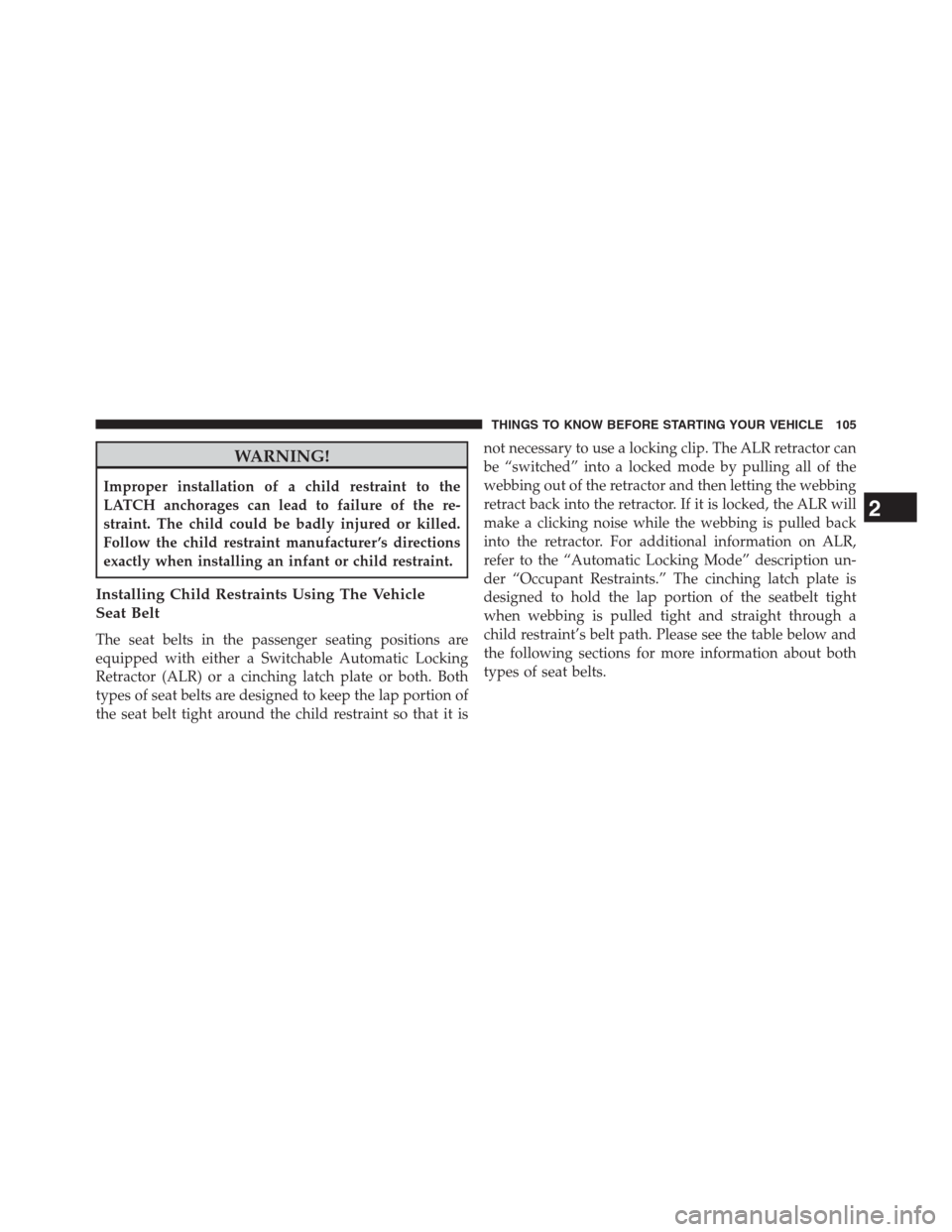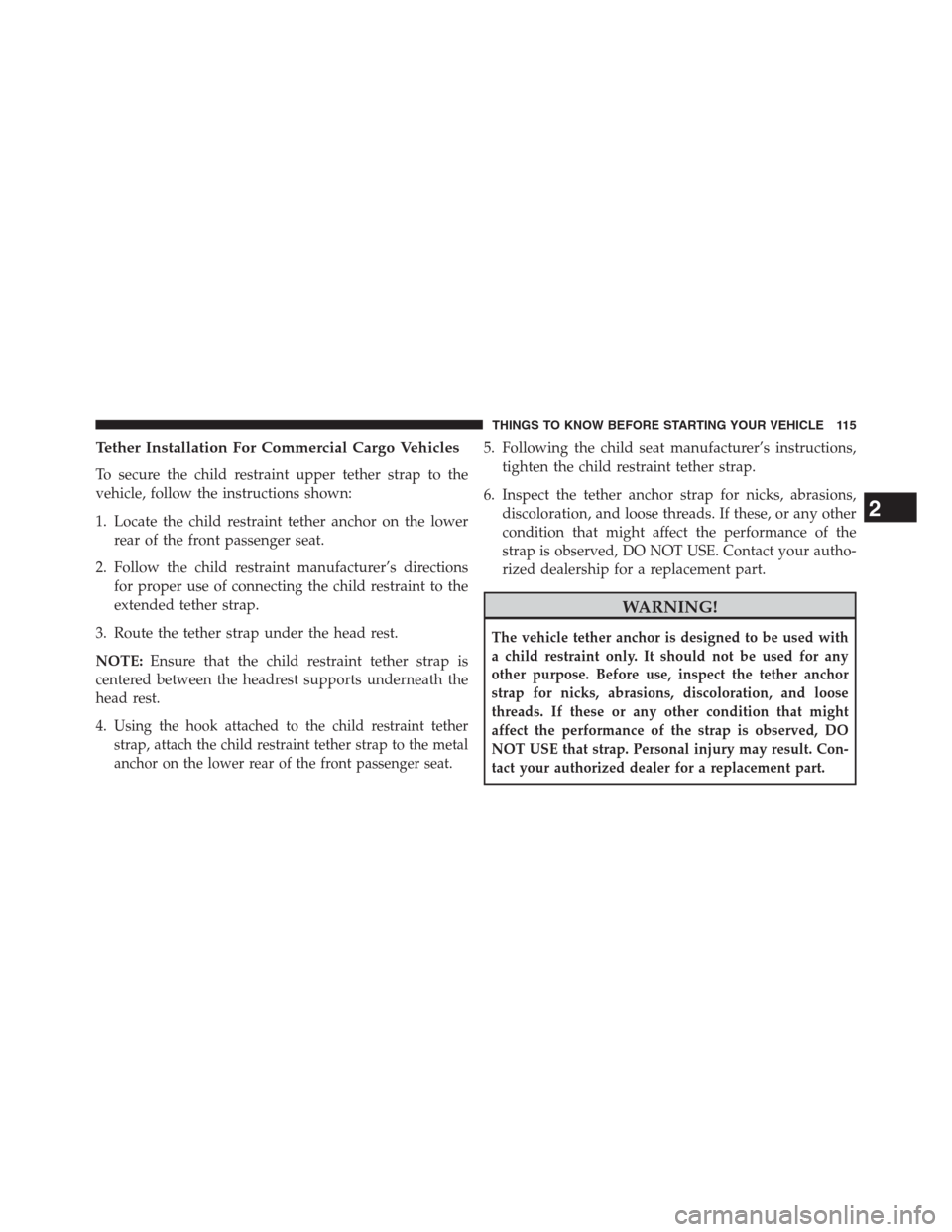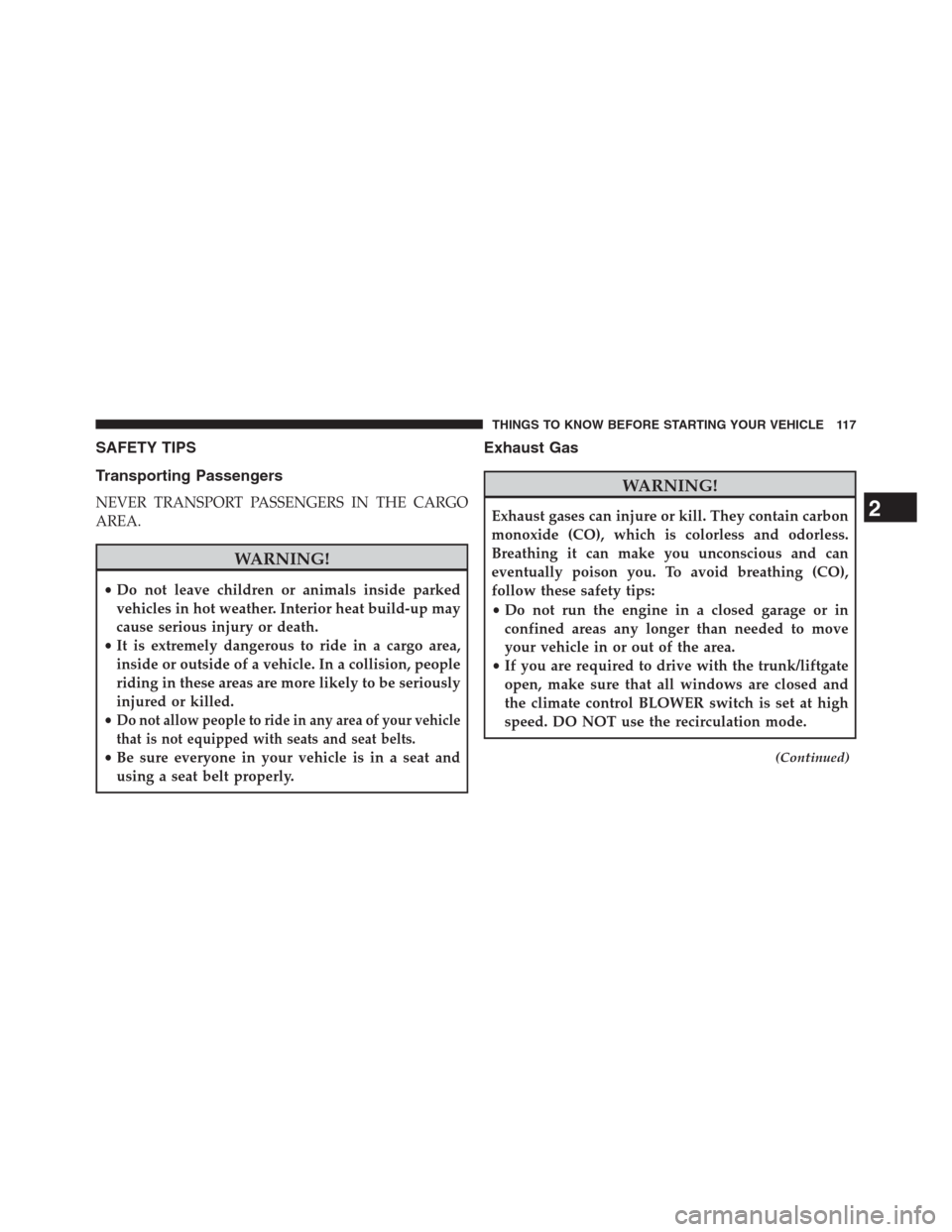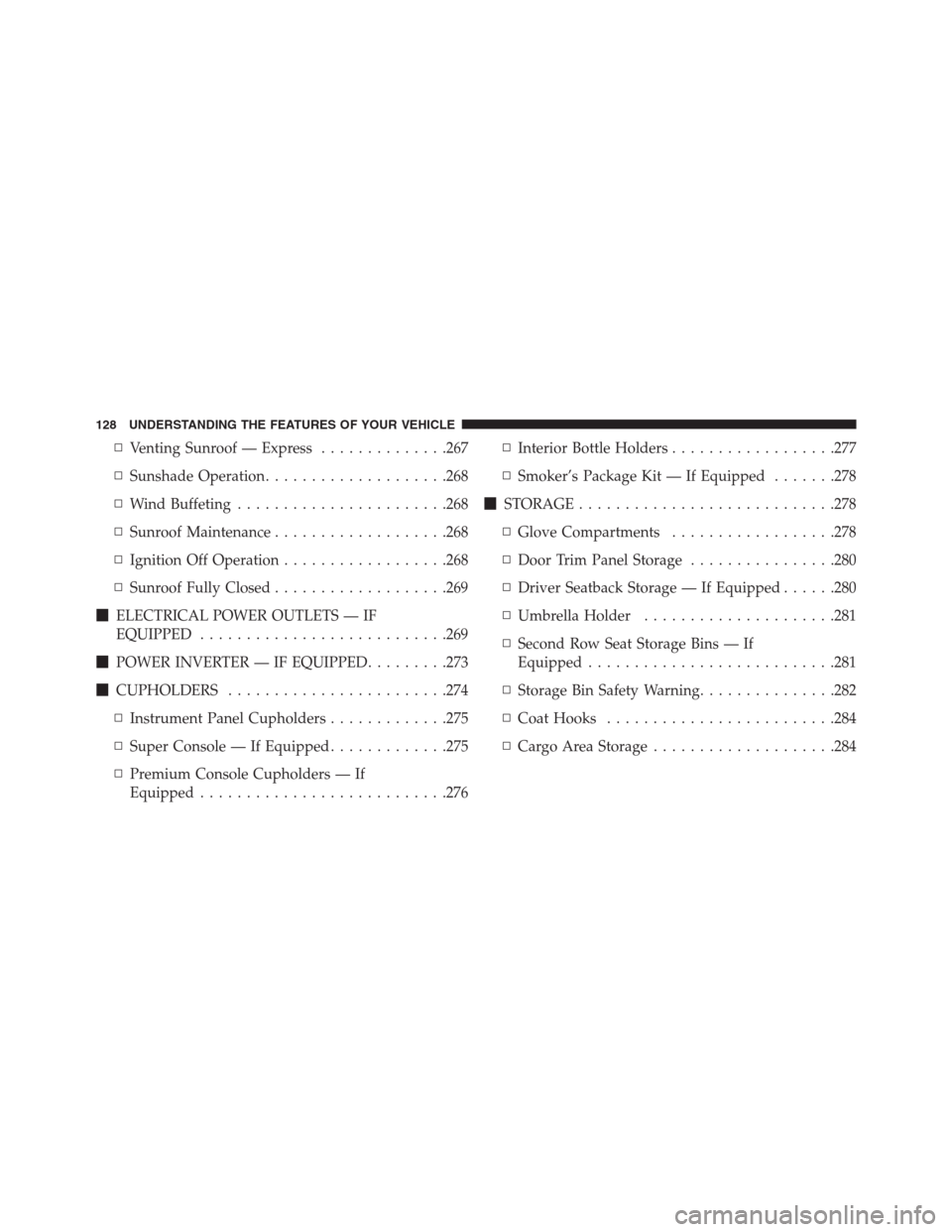Page 105 of 683

Center Seat LATCH
If a child restraint installed in the center position blocks
the seat belt webbing or buckle for the outboard position,
do not use that outboard position. If a child seat in the
center position blocks the outboard LATCH anchors or
seat belt, do not install a child seat in that outboard
position.
WARNING!
Never use the same lower anchorage to attach more
than one child restraint. Please refer to “Installing
The LATCH-Compatible Child Restraint System” for
typical installation instructions.
Always follow the directions of the child restraint manu-
facturer when installing your child restraint. Not all child
restraint systems will be installed as described here.
To Install A LATCH-compatible Child Restraint
1.If the selected seating position has a Switchable Auto-
matic Locking Retractor (ALR) seat belt, stow the seat
belt, following the instructions below. See the section
“Installing Child Restraints Using the Vehicle Seat Belt”
to check what type of seat belt each seating position has.
2. Loosen the adjusters on the lower straps and on the
tether strap of the child seat so that you can more
easily attach the hooks or connectors to the vehicle
anchorages.
3. Place the child seat between the lower anchorages for
that seating position. For some second row seats, you
may need to recline the seat and / or raise the head
restraint to get a better fit.
2
THINGS TO KNOW BEFORE STARTING YOUR VEHICLE 103
Page 107 of 683

WARNING!
Improper installation of a child restraint to the
LATCH anchorages can lead to failure of the re-
straint. The child could be badly injured or killed.
Follow the child restraint manufacturer ’s directions
exactly when installing an infant or child restraint.
Installing Child Restraints Using The Vehicle
Seat Belt
The seat belts in the passenger seating positions are
equipped with either a Switchable Automatic Locking
Retractor (ALR) or a cinching latch plate or both. Both
types of seat belts are designed to keep the lap portion of
the seat belt tight around the child restraint so that it isnot necessary to use a locking clip. The ALR retractor can
be “switched” into a locked mode by pulling all of the
webbing out of the retractor and then letting the webbing
retract back into the retractor. If it is locked, the ALR will
make a clicking noise while the webbing is pulled back
into the retractor. For additional information on ALR,
refer to the “Automatic Locking Mode” description un-
der “Occupant Restraints.” The cinching latch plate is
designed to hold the lap portion of the seatbelt tight
when webbing is pulled tight and straight through a
child restraint’s belt path. Please see the table below and
the following sections for more information about both
types of seat belts.
2
THINGS TO KNOW BEFORE STARTING YOUR VEHICLE 105
Page 117 of 683

Tether Installation For Commercial Cargo Vehicles
To secure the child restraint upper tether strap to the
vehicle, follow the instructions shown:
1. Locate the child restraint tether anchor on the lower
rear of the front passenger seat.
2. Follow the child restraint manufacturer’s directions
for proper use of connecting the child restraint to the
extended tether strap.
3. Route the tether strap under the head rest.
NOTE:Ensure that the child restraint tether strap is
centered between the headrest supports underneath the
head rest.
4.
Using the hook attached to the child restraint tether
strap, attach the child restraint tether strap to the metal
anchor on the lower rear of the front passenger seat.
5. Following the child seat manufacturer’s instructions,
tighten the child restraint tether strap.
6. Inspect the tether anchor strap for nicks, abrasions,
discoloration, and loose threads. If these, or any other
condition that might affect the performance of the
strap is observed, DO NOT USE. Contact your autho-
rized dealership for a replacement part.
WARNING!
The vehicle tether anchor is designed to be used with
a child restraint only. It should not be used for any
other purpose. Before use, inspect the tether anchor
strap for nicks, abrasions, discoloration, and loose
threads. If these or any other condition that might
affect the performance of the strap is observed, DO
NOT USE that strap. Personal injury may result. Con-
tact your authorized dealer for a replacement part.
2
THINGS TO KNOW BEFORE STARTING YOUR VEHICLE 115
Page 119 of 683

SAFETY TIPS
Transporting Passengers
NEVER TRANSPORT PASSENGERS IN THE CARGO
AREA.
WARNING!
•Do not leave children or animals inside parked
vehicles in hot weather. Interior heat build-up may
cause serious injury or death.
•It is extremely dangerous to ride in a cargo area,
inside or outside of a vehicle. In a collision, people
riding in these areas are more likely to be seriously
injured or killed.
•
Do not allow people to ride in any area of your vehicle
that is not equipped with seats and seat belts.
•Be sure everyone in your vehicle is in a seat and
using a seat belt properly.
Exhaust Gas
WARNING!
Exhaust gases can injure or kill. They contain carbon
monoxide (CO), which is colorless and odorless.
Breathing it can make you unconscious and can
eventually poison you. To avoid breathing (CO),
follow these safety tips:
•Do not run the engine in a closed garage or in
confined areas any longer than needed to move
your vehicle in or out of the area.
•If you are required to drive with the trunk/liftgate
open, make sure that all windows are closed and
the climate control BLOWER switch is set at high
speed. DO NOT use the recirculation mode.
(Continued)
2
THINGS TO KNOW BEFORE STARTING YOUR VEHICLE 117
Page 121 of 683

Air Bag Warning Light
The light should come on and remain on for four
to eight seconds as a bulb check when the
ignition switch is first turned ON. If the light is
not lit during starting, see your authorized
dealer. If the light stays on, flickers, or comes on while
driving, have the system checked by an authorized dealer.
Defroster
Check operation by selecting the defrost mode and place
the blower control on high speed. You should be able to feel
the air directed against the windshield. See your autho-
rized dealer for service if your defroster is inoperable.
Floor Mat Safety Information
Always use floor mats designed to fit the footwell of your
vehicle. Use only floor mats that leave the pedal area
unobstructed and that are firmly secured so that they
cannot slip out of position and interfere with the pedals
or impair safe operation of your vehicle in other ways.
WARNING!
Pedals that cannot move freely can cause loss of
vehicle control and increase the risk of serious per-
sonal injury.
•Always make sure that floor mats are properly
attached to the floor mat fasteners.
•
Never place or install floor mats or other floor cover-
ings in the vehicle that cannot be properly secured to
prevent them from moving and interfering with the
pedals or the ability to control the vehicle.
(Continued)
2
THINGS TO KNOW BEFORE STARTING YOUR VEHICLE 119
Page 127 of 683

�DRIVER MEMORY SEAT — IF EQUIPPED. . . .215
▫Setting Memory Positions And Linking RKE
Transmitter To Memory.................216
▫Easy Entry/Exit Seat (Available With Memory
Seat ONLY)..........................218
�TO OPEN AND CLOSE THE HOOD.........220
�LIGHTS.............................222
▫Headlight Switch......................222
▫Automatic Headlights — If Equipped.......222
▫Headlights On With Wipers — If Equipped . . .223
▫Headlight Delay — If Equipped...........223
▫Lights-On Reminder...................224
▫Daytime Running Lights — If Equipped.....224
▫Front Fog Lights — If Equipped...........224▫Dimmer Controls.....................225
▫Multifunction Lever...................227
▫Turn Signals.........................227
▫Lane Change Assist...................228
▫High/Low Beam Switch................228
▫Flash-To-Pass........................228
▫Battery Protection.....................228
�WINDSHIELD WIPER AND WASHERS......229
▫Intermittent Wiper System...............230
▫Windshield Wiper Operation.............230
▫Windshield Washers....................230
▫Mist Feature.........................230
3
UNDERSTANDING THE FEATURES OF YOUR VEHICLE 125
Page 130 of 683

▫Venting Sunroof — Express..............267
▫Sunshade Operation....................268
▫Wind Buffeting.......................268
▫Sunroof Maintenance...................268
▫Ignition Off Operation..................268
▫Sunroof Fully Closed...................269
�ELECTRICAL POWER OUTLETS — IF
EQUIPPED...........................269
�POWER INVERTER — IF EQUIPPED.........273
�CUPHOLDERS........................274
▫Instrument Panel Cupholders.............275
▫Super Console — If Equipped.............275
▫Premium Console Cupholders — If
Equipped...........................276▫Interior Bottle Holders..................277
▫Smoker’s Package Kit — If Equipped.......278
�STORAGE............................278
▫Glove Compartments..................278
▫Door Trim Panel Storage................280
▫Driver Seatback Storage — If Equipped......280
▫Umbrella Holder.....................281
▫Second Row Seat Storage Bins — If
Equipped...........................281
▫Storage Bin Safety Warning...............282
▫Coat Hooks.........................284
▫Cargo Area Storage....................284
128 UNDERSTANDING THE FEATURES OF YOUR VEHICLE
Page 131 of 683
�CONSOLE FEATURES...................285
▫Basic Console........................285
▫Premium Console — If Equipped..........286
▫Super Console — If Equipped.............290
�CARGO AREA FEATURES................292
▫Rechargeable Flashlight.................292�REAR WINDOW FEATURES..............293
▫Rear Window Defroster.................293
�LOAD LEVELING SYSTEM — IF EQUIPPED . .294
�ROOF LUGGAGE RACK — IF EQUIPPED. . . .295
▫Deploying the Crossbars.................296
�SUN SCREENS — IF EQUIPPED............301
3
UNDERSTANDING THE FEATURES OF YOUR VEHICLE 129